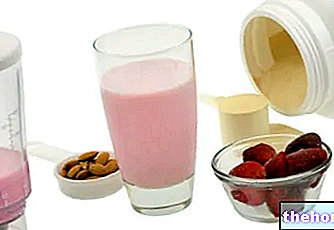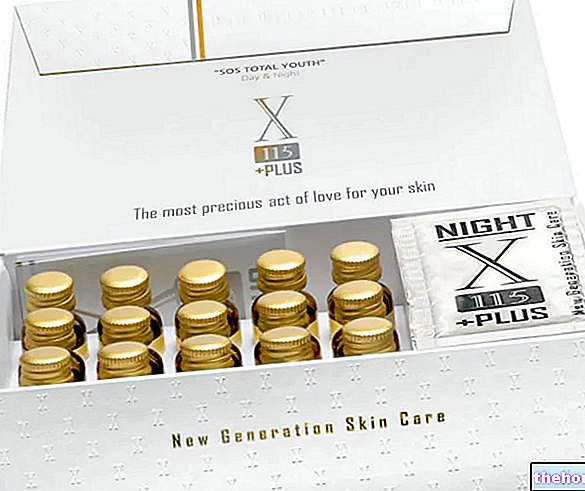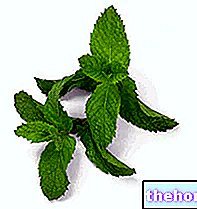See also: coumarin in cosmetics
Coumarins are a family of natural substances widely distributed in the plant world. From a chemical point of view, these are derivatives of 5,6-benzo-2-pyrone, better known as coumarin.

The term coumarin derives from the Coumarona odorata, a legume from South America from which the molecule was first isolated back in 1820.
In the plant world, coumarins can be found both in free and glycosidic form, that is, linked as an aglycone to a sugary part. The great structural heterogeneity of these substances reflects an equally wide pharmacological-therapeutic variability.
Coumarins with phlebotonic action

Coumarins with anticoagulant action
When, at the end of the 19th century, North American breeders introduced sweet clover (sweet clover) to their pastures and to feed their livestock, a "hemorrhagic epidemic soon appeared, which only a few years later was discovered to be linked to the use of this new forage.


An example of vegetable substances with hypotensive and spasmolytic properties - therefore capable of inhibiting the spastic contraction of gastro-enteric and genito-urinary smooth muscles associated with cramp-like or colic-type pains - is given by coumarins of Viburnum prunifolium (scopoletine) and "Angelica" ("essential oil extracted from the roots).

Coumarins with antibacterial and antiviral action
The umbelliferone present in the aerial parts of Pilosella and in the resins of many Umbelliferae - in addition to being used as a sunscreen - has shown interesting antibiotic properties, especially against Brucella, the etiological agent of Brucellosis. The aforementioned esculetin, on the other hand, exhibits properties bacteriostatic and antifungal, while daphnoretine and 3-phenylcoumarins showed anti-hepatitis B and anti-HIV properties, respectively.

Coumarins with anti-inflammatory action
The coumarin of Sweet Clover promotes healing and tissue regeneration, thanks to the anti-edema, capillarotropic and stabilizing properties of the erythrocyte membrane (counteracts the increase in vascular permeability, a very important element in inflammatory phenomena). Esculetin, on the other hand, inhibits the synthesis of prostanoids (prostaglandins, thromboxanes and leukotrienes), molecules involved in asthmatic, allergic and inflammatory reactions.
Coumarins with photosensitizing action

Side effects of coumarins
Particular caution should be taken in the use of dried coumarin-based herbs, due to the aforementioned ability to produce dicumarol in particular situations (see fermentation of Sweet Clover). For obvious reasons, these preparations are absolutely contraindicated in patients on anticoagulant therapy (coumadin , sintrom) or antiplatelet (aspirin, clopidogrel, etc.). It must be said, however, that coumarin and other coumarins in themselves do not possess noteworthy anticoagulant activities, so on the phytotherapeutic level they should not be confused with dicumarol and its applications Therapeutic. Devil's claw, boldo, fenugreek and Chinese angelica are examples of coumarin drugs for which important episodes of drug interaction have been reported, with increased anticoagulant activity of drugs such as warfarin.

Among the coumarin derivatives, the aflatoxins produced by molds of the genus Aspergillus starting from coumarins, play a very important toxicological role, because they significantly increase the risk of primary liver cancer. Coumarin itself is moderately toxic to the liver and kidneys.
Finally, due to their potential toxicity, coumarins are contraindicated in pregnancy and lactation.
Select plant Fir Acacia Acerola Sorrel Yarrow Yarrow Yarrow Aconito Adatoda Garlic Agnocasto Agrimonia Alchemilla Alkekengi Aloe Altea Witch Hazel Ammi or Visnaga Pineapple Andrographis Anemone Pulsatilla Angelica Anise Star Anise Japanese Star Anise Bitter Orange Bitter Areca Arnica Harpagophytum Arpagophyte Artemisia Asteragus Basil Asparagus Asparagus Peruvian Asparagus Asparagus Asparagus Hawthorn Boldo Borage Shepherd's Purse Boswellia Bucco Butea superba Cocoa Coffee Cajeput Calamus Calamus Marigold Camedrio Chamomile Roman Chamomile Camphor Cinnamon Ceylon Maidenhair Capuchin Artichoke Cardamom Cardiac Thistle Asian Thistle Carvi Cascara Cassia Catecu Catha Cabbage Celandine Chicory Centaurea Cinnamon Cypress Celandine Chives Cypress Coca Cola Colchico Combreto Condurango Comfrey Coriander Cranberry Barberry American Chrysanthemum Cumin Turmeric Damiana Digital Dioscorea Drosera Dulcamara Dunalilella Echinacea Eder a Ephedra Elenio Eleutherococcus Helichrysum Evening primrose Horsetail Alfalfa Erica Euphrasia Erisimo Escolzia Eucalyptus Farfara Farfaraccio Calabar bean Fenugreek Fennel Phytolacca Frangola Ash Fumaria Japanese Mushrooms Galega Ganoderma lucidum Garcinia Cambogia Mulberry Gentian Broom Ginkgo Ginkgo Guipana Guipana Gynestra Ginkgo Hibelia Gymnasium Hibiscus Guarulp St. John's Wort Horse Chestnut Ispaghul Hyssop Jaborandi Kava kava Konjac Laminaria Cherry Laurel Lavender Lemongrass Lespedeza Lovage Icelandic Lichen Lemon Flax Lippia Licorice Lobelia Hops Maca Marjoram Maize Mallow Manna Marrubio Marrubio d "water Matè Melaleuca Meliloto American Lemon balm Myrtle Myrama Walnut Nutmeg Walnut vomica Olive tree Meadowsweet Ononide Opuntia Oregano Orthosiphon Nettle Poppy Papaya Parietaria Feverfew Passiflora Chilli Perilla Periwinkle Phyllanthus Plantain Picrorhiza Pilosella Pino Pisci dia Podofillo Polygala Grapefruit Parsley Psyllium Pueraria mirifica Butcher's broom Pygeum Quassia Oak Rhubarb Ratania Rauwolfia currant Castor bean Rhodiola Rosehip Rosemary Rue Willow Sarsaparilla Sage Elderberry Sassafras Sedum Ergot Senna Serenoa Repens Soybean Solidago Tansy Taraxus Tamarind Tamarind Tamarind Tamarind Tamarindo Ursina Valerian Vanilla Mullein Verbena Veronica Viburnum Vinca Pansy Mistletoe Vine Withania Yohimbe Saffron Ginger Pumpkin Select disease Juvenile Acne Rosacea Tinnitus Tinnitus Aerophagia Tendon Affections Afonia Aphthae Algias Functional Halitosis Breastfeeding Allergy Anemia Anguish Anxiety Arteriosclerosis Asthrosis Asthrosis Arthritis Arthritis Men Sex Woman Blepharitis and Conjunctivitis Eye bags Bronchitis Gallstones Kidney stones Salivary stones Baldness Androgenetic Candida Fragile hair Caries Headache Cellulitis Motion sickness Cystitis C limaterio Cholecystopathy High cholesterol Ulcerative colitis Colonoscopy Bruises Hematomas Convalescence CouperoseDepression Dermatitis Diaper Dermatitis Diabetes Diarrhea Erectile dysfunction Dyslipidemia Dysmenorrhea Dyspepsia Visual disturbances Haemorrhoids Epistaxis Erethism Cardiac Fever Fibromyalgia Flatulence Phlebitis Gastritis Chilblains Gingivitis Herpes Loss of appetite Throat hypertension Hypertension Hypertension Hypertension Hypertension Throat Prosthiasis Flu Insomnia Hypertension Hypertension Intestinal disease Menopause Meteorism Mononucleosis Alzheimer's disease Crohn's disease Nausea Vomiting Obesity Dark circles Onychomycosis Osteoporosis Dry skin Periarthritis Piorea Low blood pressure Prostatitis Psoriasis Colds Breast fissures Anal fissures Gastroesophageal reflux Nasopharyngitis Rolls (abdominal fat) Symptoms Salmonella streaks Stomatitis Stress Cough High triglycerides Ulcer Burns Brittle nails Hot flashes Warts Dizziness Herbal properties Tanning Abo rtive adaptogenic Aphrodisiac bittering analgesic anesthetic anorectics analgesic antacid anti-allergic anti-asthmatic Antibiotic catarrh Anticellulitiche anticonvulsant Antidiaforetiche antidiarrheal edematous anthelmintic antiemetic Antiemorroidarie antiphlogistic Antiidrotiche Antinevrotiche Antioxidants antipyretic antirheumatic antiscorbutic Antiseptic antispasmodic anti-uric Aperitive Flavoring Astringent Balsamic Bechiche Capillarotrope cardiotonic Carminative Cathartic caustics Cicatrizant cholagogue choleretic Dyes Decongestants Deodorants purifying Detergents diaphoretic Disinfectants Detoxifiers Thirst quenching Diuretics Exciting Emetics Emmenagoghe Emollients Haemostatic Energy Hepatoprotective Expectorants Eupepticics Photosensitizing Galactophores Galactofuges Galactogogues Moisturizing Immunostimulants Hypertensive Hypnotic Hypoglycemic Nourishing Hypotensive Narcotic Odontalgic Pectoral Purgative Revulsive Remineralizing Refreshing Rubefacient Slagogues Sedative Soporiferous Sneezing Stomachic Stomatics Narcotic Tenifuges Tonic Vasoconstrictors Vasodilators Vermifuges Vescicators Vitamins Vulneraries




























